Our beloved sausage dogs are so popular among pet lovers for many different reasons, and one of them is that dachshunds come in a tremendous variety of colours and patterns. This article explores all dachshund colours & patterns that exist today.
In this article, we will cover all the aspects of the dachshund coat colours, including its origins and genetics. We will explore how many colours in dachshunds exist, and what are the most popular ones.
We will also discuss the diluted colours and the difference between a colour and a pattern in dachshunds. Finally, we will talk about genetic health concerns associated with specific hues and patterns.
Dachshund Colour Chart

You might be surprised at just how many different options there are when it comes to colours in dachshunds. There is such a wide variety, in fact, that if you are a new prospective dachshund owner, you could find yourself being spoilt for choice.
In fact, not only is there a wide variety of different hues to choose from, but also various patterns and even fur types. In this article, we will mostly focus on dachshunds’ colours and patterns.
There are six primary coat colours in dachshunds:
- Red
- Cream
- Black & Tan
- Black & Cream
- Chocolate & Tan
- Chocolate & Cream
Breeders have introduced a range of new “fashionable colours” into the mix as well, namely Gray (Blue) and Fawn (Isabella). We will explore a bit further in the article when we come to look at diluted colours in dachshunds.
The UK kennel clubs and the AKC (American Kennel Club) are very strict on the dachshund breed standard, and any deviation from the hues listed above is not permissible by them. You will want to keep this in mind if choosing a puppy from a litter to develop a show career or breed it in the future.
The main reason for the strictness on coat colours is that introducing some of the rare hues can lead to the offsprings with genetic health conditions. ( For instance, double dapple dachshunds).
The sad fact is that because these more rare colour variations are more desirable due to being “in trend,” the puppies are often sold at a premium, despite the health implications. So this is definitely something to think about if you find yourself admiring an unusually coloured dachshund pup.
If you are based in the US, there tends to be more leniency when it comes to colours and pigments in dachshund coats, and the same goes for other countries in which even less regulation exists. It is indeed how these more rare hues have begun to circulate on the market, ending up in the gene pool and therefore becoming more readily available.
The Most Popular Dachshund Colours
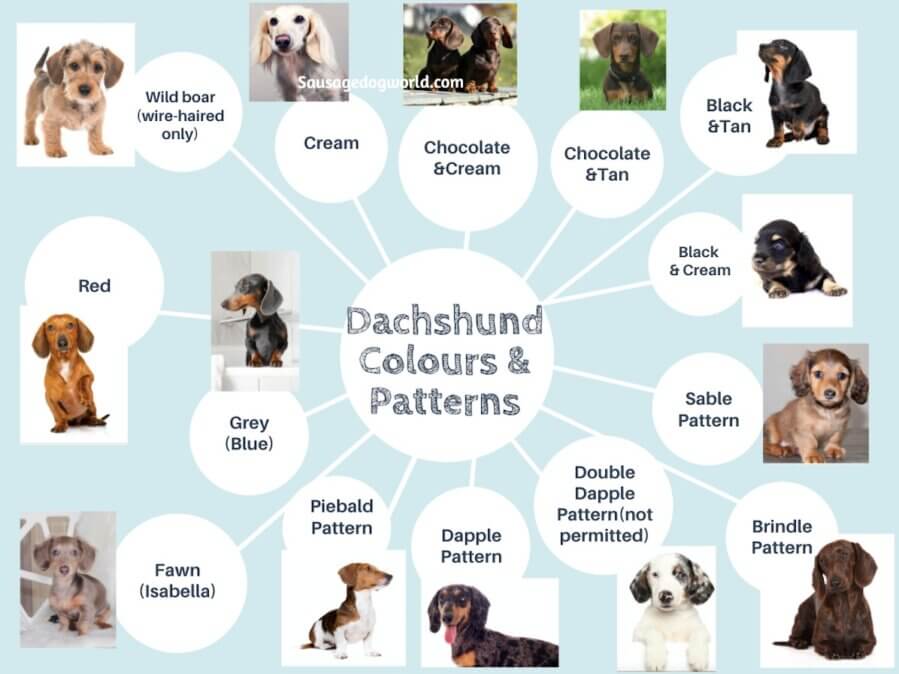
Two of the most common Weiner dogs’ colours are Red and Black&Tan. Let’s look in detail at these beautiful colours.
Red dachshund
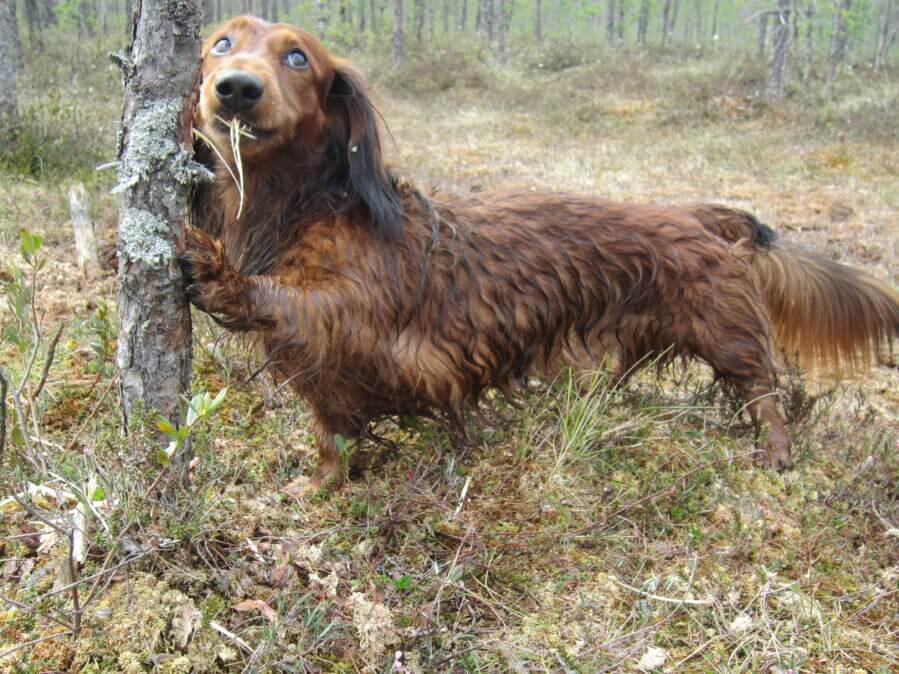
The most popular dachshund colour, and indeed the most readily available, is Red. In fact, Red dachshunds have brown hue with a reddish tint to it, and they can range from a light golden-red to more profound and dark mahogany.
The colour of the red dachshund is mostly one solid red, but there can be variations with black shading occurring either as an overlay or around the ears, back, or tail. It is also more common in longhaired dachshunds, and you may find that the black overlay fades as a puppy gets older.
Red dachshunds typically have brown eyes, black nails, and a black nose. Sometimes they will have hazel eyes, which are more of a greenish-brown hue, brown nails, and a brown nose instead of black.
The best way to help your dachshund live longer?
Watch our video to find out!
Black and Tan Dachshund

The second most popular is black and tan. These dogs are mostly solid black with tan points above the eyes, which add something to their expressiveness, and also around the nose/muzzle, feet, chest, and under the tail. The tan colour is usually the same shade as the red in red dachshunds. Black and tan dachshunds have dark brown eyes, black nails, and a black nose.
The Diluted Colours In Dachshunds & Genetics Behind Them
When we talk about “fashionable” colour variations, we are actually referring to diluted colours in dachshunds.
Diluted coat colours in dachshunds include:
- Blue (grey)
- Isabella (lilac or fawn)
Blue dachshund
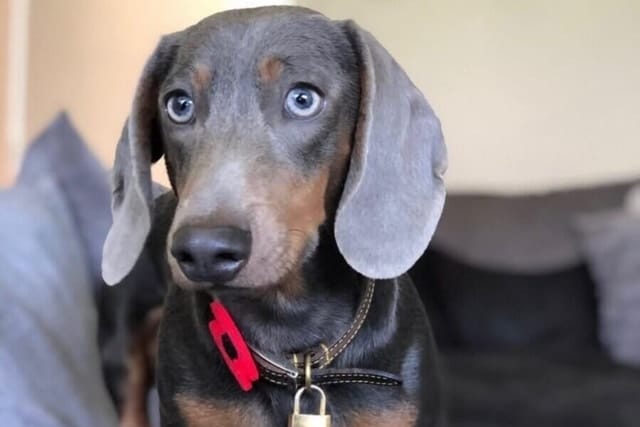
Blue is a dilution of black and has the appearance of being a beautiful grey colour, often with tan areas. An interesting feature of blue dachshunds is that their nails, paw pads, and noses are often of the blue-colour as well.
The blue tone is achieved by breeders continuously breeding a recessive gene, which results in the dilution of the black colouring in the dachshund’s coat. The new shades of grey resemble the rare “blue” hue.
The blue hue in dachshunds looks unusual, which is why people tend to be more attracted to it. You should be aware, however, that this colour is not a natural occurrence. Some kennel clubs consider the breeding of blue coats in dachshunds unethical. Breeding of dilute colours can actually be the cause of specific health issues.
The UK Kennel Club that sets breed standards actually states that the blue colour in dachshunds is “highly undesirable.” Unfortunately, when something is rare, people tend to want it more, and such rare colours like the blue coat in dachshunds become trendy and more “desirable” amongst pet owners, which is also why prices begin to soar.
Isabella dachshund

Isabella is another rare dachshund colour, and it is a dilution of chocolate. These fawn tinged coats are often referred to as lilacs, and similarly to the blue dachshunds, dachshunds with Isabella coats often also have brown nails, paw pads, and noses, making them stand out from the crowd.
The lilac tone is achieved again by breeding a recessive gene in order to dilute the chocolate colour of the dachshund coat.
The UK Kennel club also classifies Isabellas as “highly undesirable” as a breed standard, but the Isabella colour is acceptable in the US in two-colour dachshunds according to the American Kennel Club breed standards.
We will look at the genetic health concerns of dachshund colours further on in the article.
Rarest Dachshund Colours
There are certain hues in dachshunds that you won’t encounter often. They are uncommon for different reasons; ones for genetic health issues associated with the colour, others because they are not easy to reproduce.
The rare coloured dachshunds are:
- White dachshunds,
- English Cream dachshunds,
- Blue dachshunds,
- or solid Chocolate dachshunds.
You may be surprised to find out that you can indeed find blue-eyed dachshunds with intricate pattern&white patches over their coat or even all-white dachshunds. These dogs carry a “double merle” gene (double dapple dachshunds).
As with all “rare” or selectively bred coat types in dogs, you should be wary of acquiring a white-coated dachshund, as they can come with their set of health problems, including congenital blindness and deafness. In fact, some double dapple dachshund puppies can be born with malformed or missing eyes/ears and will be partially or totally deaf/blind. (see picture below)

White dachshunds should never be bred purposefully, and pet owners should avoiding buying them as this only serves to fuel the trade.
Don’t confuse a white dachshund with a very pale cream dachshund, you can read our article about Cream Dachshunds here.
UK Kennel Club breed standard states that there should be no white present in the coat of a dachshund. As an exception, it may have a small white patch on the chest, although it isn’t desirable.
In the US, Dapple dachshunds may have a large white patch on their chest. Piebald dachshunds are allowed to have white in the coat, but it mustn’t cover more than half of the head, and the ears must not be white either.
The Difference Between Dachshund Colours And Patterns
As well as the diversity of colours, there is also a variety of different patterns, which makes the options even more varied and exciting.
Patterns refer to how the hue appears over the coat when it is not a single block of colour. Without a doubt, patterns can create some stunning effects on the dachshund’s coat.
These are the five dachshund coat patterns available, on each of them we wrote a separate article:
- Dapple
- Double dapple (not permissible)
- Brindle
- Sable
- Piebald
A dapple patterned coat creates a mottled effect on top of the base colour, which can look very attractive. As a rule, two dapple dachshunds should not be bred together. As mentioned earlier, it will create a “double dapple” offspring and will risk causing severe health problems. Some of the genetic health issues may include deafness, blindness, malformations, and even missing eyes or ears!
The piebald pattern is characterized by white base colour with darker spots over it. This pattern occurs in many breeds, including Beagles and Basset Hounds. Piebald dachshunds can also show some ticking (flecks or spots of colour on white areas), like on the photo below.
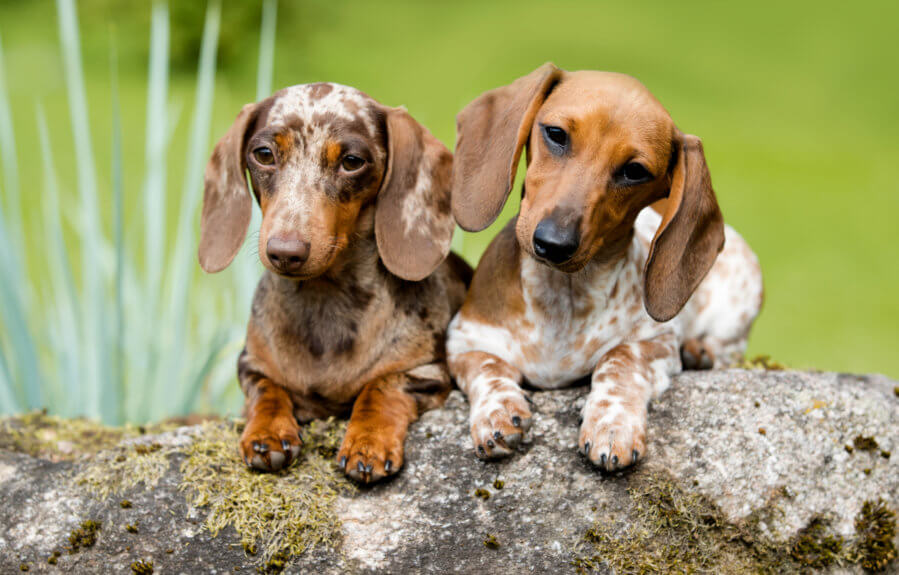
Brindle is a gorgeous coat pattern, which gives the impression of vibrant tiger-like stripes. Brindle occurs typically over a red or cream base coat and has a warm, dark hue.
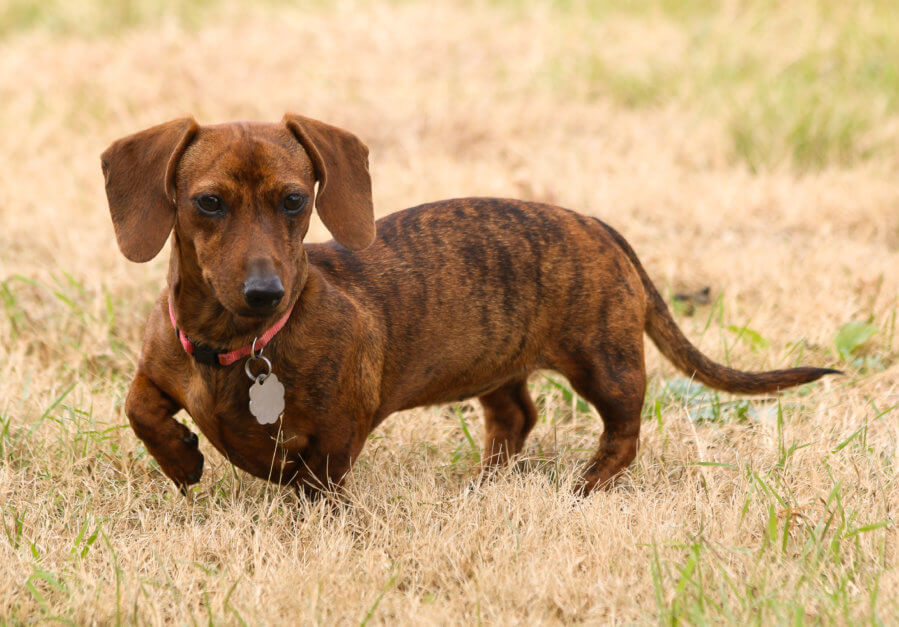
The sable pattern is exclusive to longhaired dachshunds, with the fur being red at the base and black at the tip for a rather rich and luxurious effect.
The double dapple is a non-permissible pattern and the kennel clubs don’t recognise it. It is visually similar to piebald but with the more intricate kaleidoscopic markings over the white base coat.
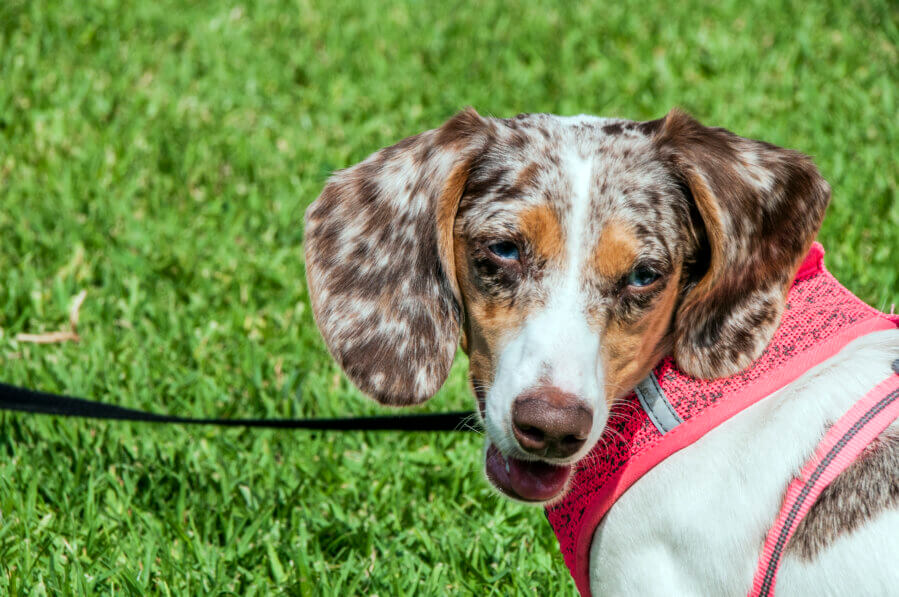
Dachshund Colours & Genetic Health Concerns
Blue and Isabella dachshunds are selectively bred for their visually stunning coats. Nevertheless, this breeding has resulted in some serious genetic health concerns due to the reproduction of recessive genes.
Blue or Fawn dachshunds are prone to a variety of conditions:
- Colour Dilution Alopecia
- Skin Cancer (and other skin issues)
- Infection
Colour Dilution Alopecia is a coat condition that causes patches of fur loss all over the dachshund’s body. This condition results in making the coat much thinner than it should be. If you are purchasing a blue or lilac coloured dachshund puppy, you should be aware that although the pup may look healthy at the point of purchase, it can start to lose the fur as soon as six months of age.
Hair loss occurs in dilute dogs because the hair strands are too thin and brittle. Hair simply falls out at the follicle, causing an unsightly patchy appearance.
The issue is not only an aesthetic one, either. Alopecia can give the dog many skin issues, leaving it itchy, flaky, and sore. It is a very uncomfortable condition for any dog to have to live with.
Skin infections and dermatitis are also inevitable because so much of the skin is being exposed. A dog’s coat is there to protect the skin, and so without healthy fur, dachshunds become more susceptible to skin cancers as they can quickly become sunburnt due to the lack of natural protection from a thick and healthy coat.
One of the most important and effective measures to prevent health problems in dachshunds is Supplementation.
We highly recommend the Dachshund Advanced Care by Breedology, it is an advanced dietary supplement, precisely formulated for the dachshund breed. Their powerful natural formula includes Chondroitin, Glucosamine and Hyaluronic Acid among other ingredients that work in perfect synergy to provide advanced joint and cartilage support for dachshunds at any age.
It also contains Barley Grass and Wheatgrass for supporting digestion, freshening breath, and giving a hearty kick-up to energy levels.
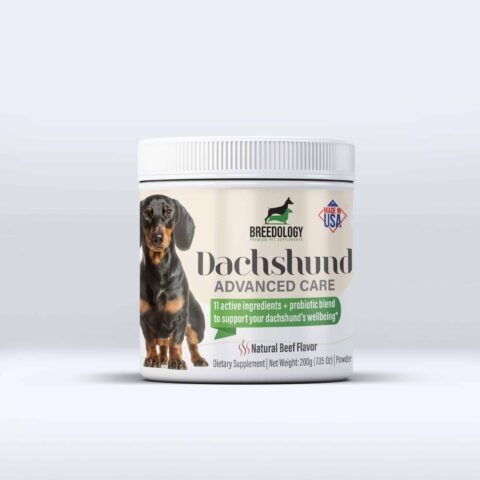
Summary
There is just so much to love about sausage dogs, from their funny look to larger than life personalities. Undoubtedly, the sweeping variety of colours and patterns makes dachshund one of the most popular dogs in the world.
Still, it is essential not to seek out rare and “new” dachshund coat types. The kennel clubs might not recognise them to avoid supporting unscrupulous breeding.
Written: By Zara M.

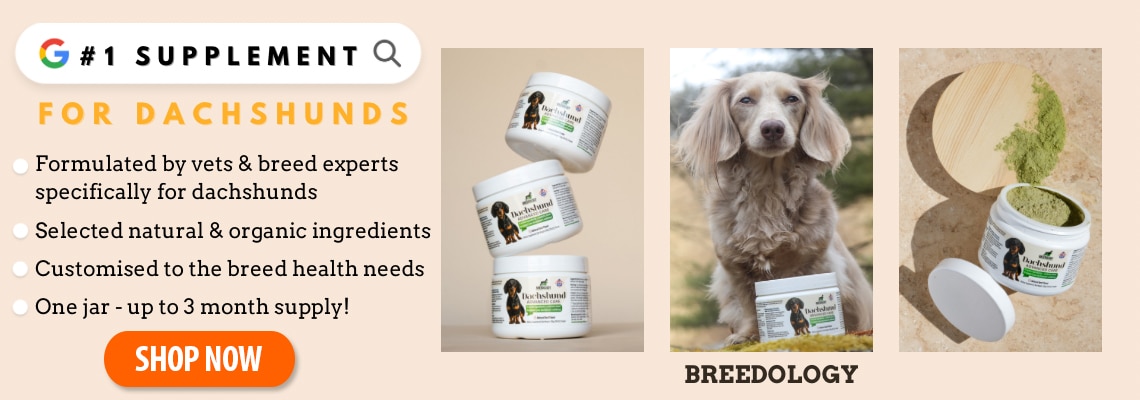
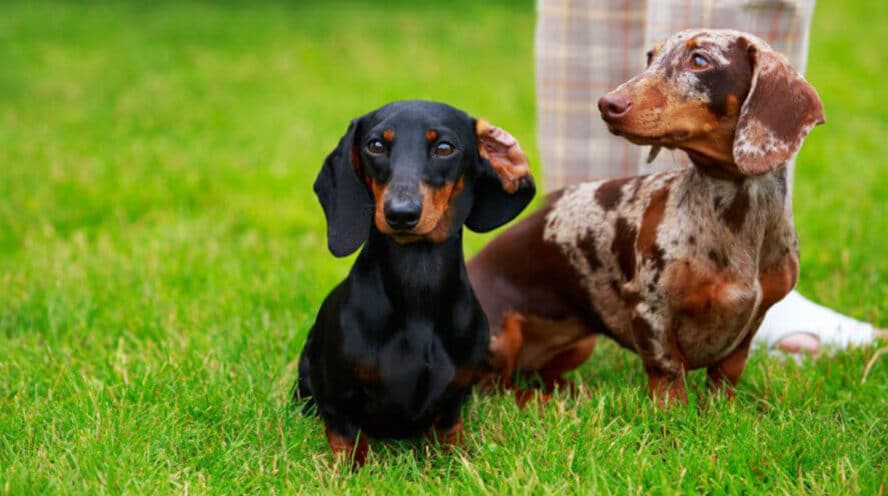
Comments
Hi what is the best color to breed my piebald male to?
We would like to hopefully have a puppy that looks like him.
To increase the chances of producing piebald puppies, choose two Dachshunds for breeding, both of which have the piebald gene (Spsp or SpsS). A visual inspection of their coat patterns is sufficient.
Hi I have a puppy who is solid chocolate and tan but she has a white chest down her belly( underneath) and four white paws. Could she be a tuxedo piebald? Parents are
Mum chocolate dapple and dad chocolate and tan ( confirmed not to have dapple gene).
Hi Mary, it is possible for a chocolate and tan Dachshund to have a white chest. While Dachshunds with the chocolate and tan coloration typically have chocolate (brown) as their primary color and tan markings on specific areas like the face, legs, and chest, variations can occur. Some Dachshunds may exhibit a white chest patch or a small amount of white on their chest, even if they have the chocolate and tan coat pattern.
Hi can you breed a chocolate dapple female with a chocolate male if not what is the best colour male
Hi Joy, yes, absolutely, considering that the other dachshund is not a dapple. You can breed with any standard solid colours ( black and tan, chocolate and cream etc). Reds, and creams – with caution, as dapple pattern might not be visible on this coat.
Hi Maria. If I breed my long haired cream with smooth haired Isabella and tan, what colour will they come out like? And could they produce longhaired?
Hello, I have a chocolate based red female. I was wondering if I could breed her to a black dapple? Would that be safe and what colours would they produce? Her father was a dapple. Or what colours would be good to breed her to?
Hi, please make sure to do a DNA test for your red female, as dapple pattern can sometimes hide in Reds. Otherwise, you can breed her, she will produce a puppies of both parents’ colours.
Hi , I have a silver dapple girl, she has cream paws , and cream around her nose and two cream dots over her eyes, and a white marking on her chest , brown eyes , her other dapple siblings are silver dapple and tan , two of the boys carry the Merle gene with one with one blue eye and one with a touch of blue in one eye , her parents were mum black and tan , dad brown dapple . They had a litter of all silver dapples and one black and tan . (7)
Can I breed my silver dapple girl with and black and tan or a chocolate brown and tan .
Any advice would be great thank you 😊
Hi Paula,
Yes, absolutely, you can breed your silver dapple dachshund with a black and tan or chocolate and tan dachshund!
Hi, I have a black + Tan girl ( mother shaded red + father dapple) and blue boy ( mother + father both blue) I would like to give my girl 1 litter, but have been told because my boy is blue not to mate because its likely the puppies would be born with health issues?
Hi, that is not true, you can breed the blue dachshunds too 🙂
Hi, what colour would my long haired cream dachshund and Isabella tan smooth hair make?
Hi,
Would it be possible to breed my mini brown dapple girl to a mini wire haired dachshund at all to possibly get any wire haired puppies or would this be very wrong (in the uk)…
Hi, yes, absolutely , considering the wire-haired dachshund does not have any dapple gene (DNA test is advisable)
Hi! So long story short. Our sire was a long smooth hair dapple. Our dam was a black silk short. Our puppy from the litter is red wild boar with really wirey hair. Now, there was a tan wire hair that may have had access to the dam at the same time. Is it possible that our sire was not the one who bred? Did we get ripped off? This woman is a certified breeder, but we think she screwed up and lied
Hi, I have an all black dachshund, except for a small white mark on his chest. Would it be best to mate with another all black? Would this result in all black puppies?
I have a chocolate and tan Dam that we bred to a Dapple Sire and the litter is a mix of dapples. Who would I be able to show our litter to be confident that our parents are an ok match ?
Hi Vicky, as I understand you bred a chocolate and tan dachshund with a dapple dachshund, and as a result received a litter of single dapples and choc and tan puppies. It is safe to breed a solid black and tan dachshund with a dapple, and having a litter like this is perfectly normal.
Hi Maria, I have a chocolate dapple girl ( her mum was a choco dapple and her dad was a soild Issabella) I’ve had her all health tested and I’ve found a kc Issabella stud who has been fully health tested to. I was planning to do this mating but do you think it would be a good idea? After reading your article I would really appreciate your advice I did Also look at a fully health tested piebald Male to but thought the Issabella would be better. Any advice would be great thank. My girl is kc registered with breeding rights.
Hi Jessie, yes, it is possible, Isabella colour is caused by a recessive dilution gene, it won’t interfere with dapple. Piebald is also possible in theory, but will create a confusion as these patterns are quite similar, and you won’t know which puppy will carry a dapple gene. Mixing these patterns is not recommended. I would suggest mating a dapple with a standard coloured dachshund (no patterns), or consider your first option.
Hi can I breed my chocolate and tan with a tan dapple male
Hi Gail,
Yes absolutely! Most likely will be a mixed litter, some solid, some dapples
Can a Black and Tan puppy have a white mark below the neck (middle of chest)? Is it considered as any impurity or less quality ?
Hi Alex, according to UK kennel clubs, – no white is permissible, save for a small patch on chest which is permitted but not desirable.
Can I breed my choc and tan boy with a choc and tan girl, even if they both had siblings that were dapple.
Hi. I have a red dapple mini longhair dachshund, could I breed him with a piebald mini longhair female??
Hello Joan, you can breed dapple with piebald with no health issues. However, better to breed dapples with solid coloured dachshunds, so you will get solid &dapple puppies. Mixed patterns are not preferred as creates confusion when breeding.
Can I breed my choc and tan boy with a choc and tan girl, even if they both had siblings that were dapple.
Hi Julia, yes, you can! According to your description, they are solid chocolate and tan dogs and did not inherit the dapple gene.
Hi can I breed my cream with a chocolate and tan? The chocolate carries one copy of cream, will there be creams in the litter, or is the chocolate the dominant colour in this possible mating
Hi I am just wondering after having the gene test done and all clear or Merle if I breed a long hair cream with a long hair dapple what colours might I get ?
Hi Natalie, what kind of dapple dachshund are we talking about? Dapple is just a pattern, it dilutes the original colours and presents a beautifully coloured pattern. You’ll definitely get some dapples in the litter, to get the cream puppies you need both parents to be of this colour.
Hi I have a Black and Tan bitch (dad is silver dapple Mam Black and Tan) I have found a red male to mate with is this a wise decision or could I pass on the double dapple gene? I plan on having her colour tested
Hi Natalie, yes, you can safely breed solid Black and Tan with any type of dachshunds!
Hi, I was reading through your replies and saw you’ve said solid Black and Tan Dachshunds are safe to breed with any type, does this include Lilac Isabella’s?
Hi Louise, Yes, absolutely! Dachshunds of solid standard colours/combinations can be bred with any other dachshund type.
Hi Maria, I have a Black and Tan longhaired female (both mum and dad are black and tan longhaired but dad may be carrying the dapple gene) and am getting a silver dapple longhaired male. Are these 2 okay to breed?
I have a healthy blue and tan bitch (no skin issues and a happy vet) (mum was Black and Tan, dad was blue and tan)and a shaded red male (dad was shaded red and mum was red). I would like to breed them simply for more family pets – no intention of selling any of them short of giving to other family members if we had a larger litter. What would your advice be with this and do you know colours we could expect if we went ahead?
Hi Poppy, there are different versions of these genes (d1/d1, d2/d2, d3/d3, d1/d2, d1/d3, or d2/d3) , (AyAy) (AtAt), and it also depends how many copies of the genes will be inherited. You can definitely breed your doxies, but it’s hard to predict what colours the pups will inherit from their parents.
Hola tengo una salchicha negra mamá negra fuego y papa arlequin plata pero mi perrita no tiene ninguna mancha arlequin será q es portadora del gen merle ?
Hello Vanessa, do you have a black&tan dachshund? Then she doesn’t, in the the litter with such parents you probably had some dapples and some solid coloured dachshunds. Yours is just black & tan. Dapple is usually visible on the coat, or can be hidden in cream and red dachshunds.
Can I breed my cream with a Black and Tan?
Hi Katie, yes, you definitely can!
What is best breeding pairing for a dapple? And why is all black not recognized? Thank you!
Best pairing for a dapple are solid coloured dachshunds. Most importantly to avoid breeding with other dapples. Keep in mind that Reds or Creams can hide dapple pattern (it might be not visible) on their coat.
Black colour is not very common, and there are official breed standards for dachshunds (including colours) that are registered.
I have a Black and Tan and mated her with a red, what colours are the pups most likely to be or 50/50
Hi Laura, it is impossible to say what percentage of pups will look after Dam and Sir, respectively; it depends on how the genes play out.
I have a red hidden dapple male. What color should I breed with him?
Hi Kerry,
Any standard coloured dachshund, (except for red and cream), like chocolate, chocolate & tan, black & cream, Black & tan etc
We have a four month old red with a white patch on her chest. I thought it was odd but we love her anyway & have no intention of breeding her. What causes the white patch? Thank you in advance!
Hi Lynda, you can test her for the presence of the Piebald gene. I assume she might be N/S genotype as opposed to S/S genotype where the dogs are expected to display more obvious piebald pattern. Dogs with N/S genotype have one copy of the S gene, and may display no white patterning or some amount of white patterning. They may transmit this piebald variant to 50% of their offsprings.
Hi Maria, I have a Black and Tan longhaired female (both mum and dad are black and tan longhaired but dad may be carrying the dapple gene) and am getting a silver dapple longhaired male. Are these 2 okay to breed?
Hi Mia, yes, that’s absolutely fine as you have two solid black & tan dachshunds
Hi Maria, we have a shaded Red with silver dapple ? Would we have to breed her with a block colour ? We was thinking a chocolate ? Any suggestions please. Thank you x
Hi Debra, breeding with any solid or two-coloured dachshund is perfectly fine.(black and tan, chocolate, black and cream etc.) Just be careful with Reds, as in Reds dapple is sometimes hidden.
Hi, Can I breed my cream longhair to a black & tan silver dapple longhair?)
Hi Pamela, you can, but you have to make sure your Cream doxie is not a dapple. (Creams can hide dapple very well!). There are simple tests for the presence of merle gene you can order online.
Hi, Can I breed my cream longhair to an Isabella (fawn and tan longhair?)
Hi Pamela, yes, you can!
Hi I am going to breed my Black and Tan mini with Issabella mini what colour will their babies be ?
Hi! My female red miniature is ready for a first litter. Should I find another red to mate her with?
Hi Juliet, you can breed your doxie with any solid and 2/coloured dachshunds, most likely it will be a litter of red puppies or puppies of different colours depending on what genes the parents pass on. Just don’t breed her with dapple dogs, as red colours sometimes hide merle gene.
Hi, How can I find out if my dachshunds are related , I got them from the same breeder. But I want to be 100% sure they are not related. Is they a way I can test there genes or something?????
Also my female is shaded red long haired and my male is red smooth that’s OK, right
Hi Elle, the easiest way is to contact the breeder, they should have records of both the Dam and the Sire of the dogs.